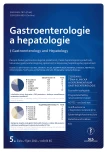No benefit of autofluorescence in a diagnosis of low grade intraepitelial neoplasia in patients with Barrett´s oesophagus
Authors:
M. Stefanová 1; M. Zavoral 1; F. Závada 1; Š. Suchánek 1; I. Tučková 2; P. Hrabal 2; J. Martínek 1
Authors‘ workplace:
Interní klinika 1. LF UK a ÚVN Praha
1; Oddělení patologie, ÚVN Praha
2
Published in:
Gastroent Hepatol 2011; 65(5): 249-254
Category:
Clinical and Experimental Gastroenterology: Original Article
Overview
Backgrounds:
Patients with Barrett’s oesophagus (BE) have an increased risk of esophageal adenocarcinoma. The aim of the surveillance program is the early detection of Barrett’s oesophagus-related neoplasia (BORN). Enhancement endoscopy such as narrow band imaging (NBI), high resolution endoscopy (HRE) and autofluorescence (AFI) are useful in the early detection of high grade intraepithelial neoplasia (HGIN) or adenocarcinoma (EAC). However, their role in the detection of low grade intraepithelial neoplasia (LGIN) remains unclear.
Design:
To evaluate the diagnostic accuracy of AFI in the detection of BORN and especially of low grade intraepithelial neoplasia in patients with Barrett’s oesophagus.
Methods:
A prospective cohort study. A total of 53 patients with Barrett’s oesophagus (mean age 63 years, range: 22–98) were referred to our tertiary centre with the following diagnoses: 10× HGIN/EAC, 28× LGIN, 15× long segment of BE with possible LGIN. All patients were examined using HRE, NBI and AFI. The targeted biopsies were taken from all visible lesions as well as from all suspect areas (based on AFI and NBI results). If no such areas were present, the standard random biopsies were taken. Results obtained from targeted biopsies are considered the final diagnosis. All slides were examined by two experienced pathologists.
Results:
In 53 patients with BE, we diagnosed 5 patients with an early adenocarcinoma (EAC), 3 patients with HGIN and 14 patients with LGIN. In the remaining 31 patients, we did not confirm any intraepithelial neoplasia. AFI was positive in 7 patients with EAC and HGIN (7/8, 87%) and in 7 patients with LGIN (7/14, 50%). On the other hand, AFI was falsely positive in 7 patients without intraepithelial neoplasia (7/31 23%). The sensitivity, specificity, PPV and NPV of AFI for detecting HGIN were 90%, 93%, 80% and 96%, respectively. The corresponding values for detecting LGIN were 50%, 77%, 50% and 77%.
Conclusion:
AFI does not seem to be beneficial in the detection of LGIN in patients with Barrett’s oesophagus, principally due to the high rate of false positive results. AFI seems to be beneficial in patients with HGIN although the cohort of patients with HGIN in our study is small.
Key words:
Barrett’s oesophagus – autofluorescence imaging – intraepithelial neoplasia
Sources
1. Riddell RH, Odze RD. Definition of Barrett's esophagus: time for a rethink--is intestinal metaplasia dead? Am J Gastroenterol 2009; 104(10): 2588–2594.
2. American Gastroenterological Association, Spechler SJ, Sharma P et al. American Gastroenterological Association medical position statement on the management of Barrett's esophagus. Gastroenterology 2011; 140(3): 1084–1091.
3. Martinek J, Suchanek S, Stefanová M et al. Radiofrekvenční ablace Barrettova jícnu. Současný stav a první vlastní zkušenosti. Folia gastroent hepatol 2009; 7(3–4): 105–111.
4. Martínek J, Beneš M, Brandtl P et al. Low incidence of adenocacinoma and high-grade intraepithelial neoplasia in patients with Barrett´s esophagus: a prospective cohort study. Endoscopy 2008; 40(9): 711–716.
5. Hamamoto Y, Endo T, Nosho K et al. Usefulness of narrow-band imaging endoscopy for diagnosis of Barrett's esophagus. J Gastroenterol 2004; 39(1): 14–20.
6. Uedo N, Iishi H, Tatsuta M et al. „A novel videoendoscopy system by using autofluorescence and reflectance imaging for diagnosis of esophagogastric cancers“. Gastrointest Endosc 2005; 62(4): 521–528.
7. Curvers WL, Herrero LA, Wallace MB et al. Endoscopic tri-modal imaging is more effective than standard endoscopy in identifying early-stage neoplasia in Barrett's esophagus. Gastroenterology 2010; 139(4): 1106–1114.
8. Filip M, Iordache S, Săftoiu A et al. Autofluorescence imaging and magnification endoscopy. World J Gastroenterol 2011; 17(1): 9–14.
9. Mannath J, Subramanian V, Hawkey CJ et al. Narrow band imaging for characterization of high grade dysplasia and specialized intestinal metaplasia in Barrett's esophagus: a meta-analysis. Endoscopy 2010; 42(5): 351–359.
10. Kara MA, Bergman JJ. Autofluorescence imaging and narrow-band imaging for the detection of early neoplasia in patients with Barrett's esophagus. Endoscopy 2006; 38(6): 627–631.
11. Wang KK, Okoro N, Prasad G et al. Endoscopic evaluation and advanced imaging of Barrett's esophagus. Gastrointest Endosc Clin N Am 2011; 21(1): 39–51.
12. Sharma P, Bansal A, Mathur S et al. The utility of a novel narrow band imaging endoscopy system in patients with Barrett's esophagus. Gastrointest Endosc 2006; 64(2): 167–175.
13. Kara MA, Peters FP, Ten Kate FJ et al. Endoscopic video autofluorescence imaging may improve the detection of early neoplasia in patients with Barrett's esophagus. Gastrointest Endosc 2005; 61(6): 679–685.
14. Pech O, Vieth M, Schmitz D et al. Conclusions from the histological diagnosis of low-grade intraepithelial neoplasia in Barrett's oesophagus. Scand J Gastroenterol 2007; 42(6): 682–688.
15. Curvers WL, van Vilsteren FG, Baak LC et al. Endoscopic trimodal imaging versus standard video endoscopy for detection of early Barrett's neoplasia: a multicenter, randomized, crossover study in general practice. Gastrointest Endosc 2011; 73(2): 195–203.
Labels
Paediatric gastroenterology Gastroenterology and hepatology SurgeryArticle was published in
Gastroenterology and Hepatology

2011 Issue 5
Most read in this issue
- Eosinophilic esophagitis
- Two faces of oesophageal cancer – epidemiology and etiology
- Radiofrequency ablation in the GI tract – the “state of the art” in the Czech Republic and worldwide
- Prognostic factors and timing of endoscopy in acute non-variceal upper gastrointestinal bleeding
